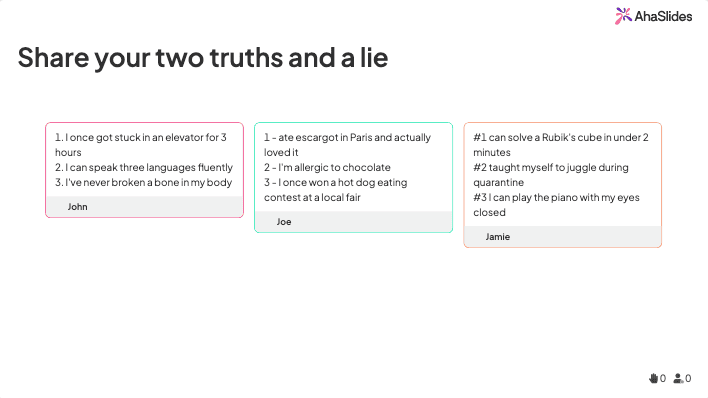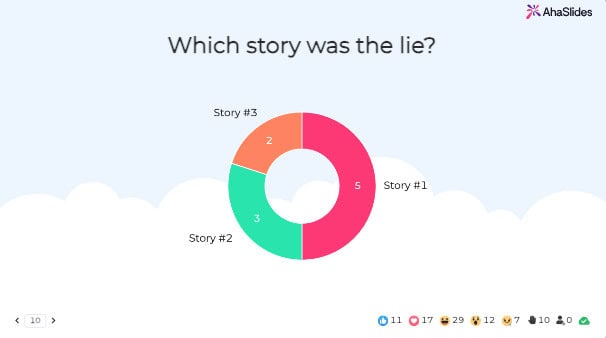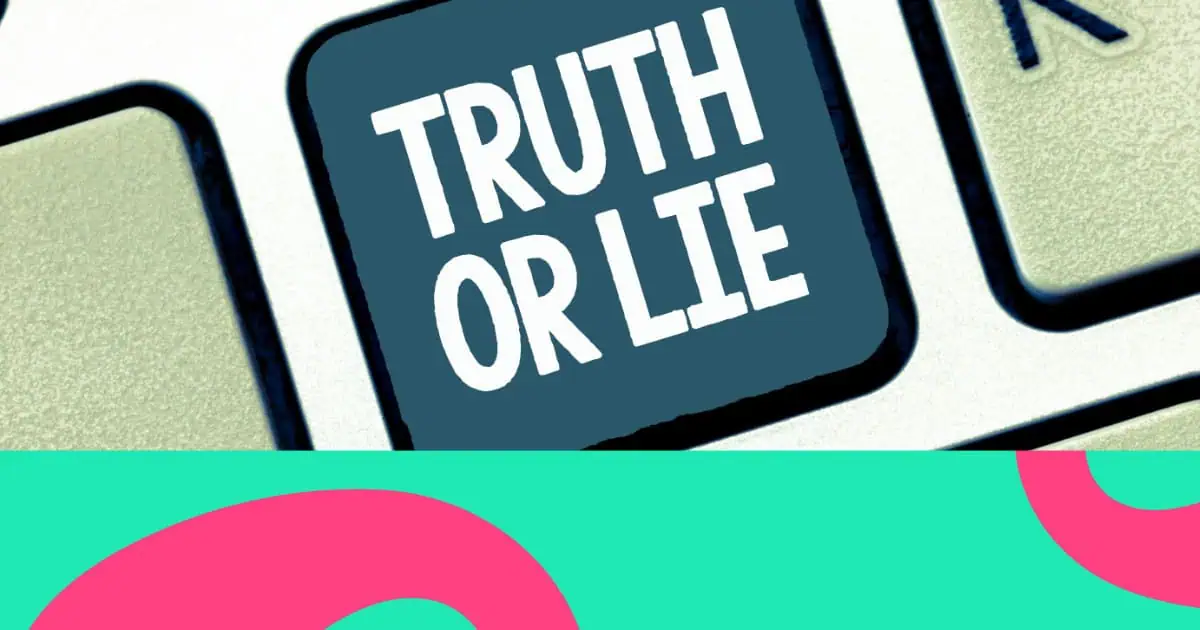Two Truths and a Lie is one of the most versatile icebreaker games you can play. Whether you're meeting new colleagues, hosting a family gathering, or connecting with friends virtually, this simple game breaks down barriers and sparks genuine conversations.
Scroll down to find 50 inspirations for this activity.
Table of Contents
What is Two Truths and a Lie?
The rule of two truths and a lie is simple. Each player shares three statements about themselves—two true, one false. Other players guess which statement is the lie.
Each player shares three statements about themselves—two true, one false. Other players guess which statement is the lie.
The game works with just 2, but is more engaging with larger groups.
Hints: Make sure what you say doesn't make others feel uncomfortable.
Variations of Two Truths and A Lie
For a time, people played Two Truths and A Lie in different styles and continually refreshed it. There are many creative ways to play the game without losing its spirit. Here are some ideas that are popular nowadays:
- Two Lies and a Truth: This version is the opposite of the original game, as players share two false statements and one true statement. The goal is for other players to identify the actual statement.
- Five Truths and a Lie: It is a level-up of the classic game as you have options to consider.
- Who Said That?: In this version, players write down three statements about themselves, mixed up and read them aloud by someone else. The group has to guess who wrote each set of ideas.
- Celebrity Edition: Instead of sharing their profile, players would make up two facts about a celebrity and a piece of unreal information to make the party more thrilling. Other players have to identify the wrong one.
- Storytelling: The game focuses on sharing three stories, two of which are true, and one is wrong. The group has to guess which story is the lie.
Check out more icebreaker games for groups.

When to Play Two Truths and A Lie
Perfect occasions for
- Team meetings with new members
- Training sessions that need an energising break
- Virtual meetings to add human connection
- Social gatherings where people don't know each other
- Family reunions to learn surprising facts about relatives
- Classroom settings for students to connect
The best timing is at
- Beginning of events as an icebreaker (10-15 minutes)
- Mid-meeting to re-energise the group
- Casual social time when conversation needs a spark
How to Play
Face-to-Face Version
Setup (2 minutes):
- Arrange chairs in a circle or gather around a table
- Explain the rules clearly to everyone
Gameplay:
- Player shares three statements about themselves
- Group discusses and asks clarifying questions (1-2 minutes)
- Everyone votes on which statement they think is the lie
- Player reveals the answer and briefly explains the truths
- Next player takes their turn
Scoring (Optional): Award 1 point for each correct guess
Virtual Version
Setup:
- Use video conferencing (Zoom, Teams, etc.)
- Consider using polling tools like AhaSlides for voting
- Keep the same turn-taking structure
Pro tip: Have players write their three statements simultaneously, then take turns reading them aloud for discussion.

50 Ideas to play Two Truths and A Lie
Two Truths and A Lie about achievements & experiences
- I've been interviewed on live television
- I've visited 15 countries across 4 continents
- I won a state championship in high school debate
- I met a celebrity at a coffee shop in Los Angeles
- I've been skydiving three times
- I once got lost in a foreign country for 8 hours
- I graduated valedictorian of my high school class
- I've run a marathon in under 4 hours
- I once had dinner at the White House
- I was born during a solar eclipse
Truths and Lies about habits
- I wake up at 5 AM every single day
- I've read the entire Harry Potter series 5 times
- I brush my teeth exactly 4 times per day
- I can speak 4 languages fluently
- I've never missed a day of flossing in 3 years
- I drink exactly 8 glasses of water daily
- I can play the piano, guitar, and violin
- I meditate for 30 minutes every morning
- I've kept a daily journal for 10 years
- I can solve a Rubik's cube in under 2 minutes
Truths and Lies about the hobby and personality
- I'm terrified of butterflies
- I've never eaten a hamburger
- I sleep with a childhood stuffed animal
- I'm allergic to chocolate
- I've never seen any Star Wars movie
- I count steps when I walk upstairs
- I've never learned to ride a bicycle
- I'm afraid of elevators and always take stairs
- I've never owned a smartphone
- I can't swim at all
Truths and Lies about family and relationships
- I'm the youngest of 12 children
- My twin sister lives in another country
- I'm related to a famous author
- My parents met on a reality TV show
- I have 7 siblings
- My grandparents were circus performers
- I'm adopted but found my birth parents
- My cousin is a professional athlete
- I've never been in a romantic relationship
- My family owns a restaurant
Truths and Lies about weirdness and randomness
- I've been struck by lightning
- I collect vintage lunch boxes
- I once lived in a monastery for a month
- I have a pet snake named Shakespeare
- I've never been on an airplane
- I was an extra in a major Hollywood movie
- I can juggle while riding a unicycle
- I've memorised pi to 100 decimal places
- I once ate a cricket (intentionally)
- I have perfect pitch and can identify any musical note
Tips for Success
Creating Good Statements
- Mix obvious with subtle: Include one obviously true/false statement and two that could go either way
- Use specific details: "I visited 12 countries" is more engaging than "I like to travel"
- Balance believability: Make the lie plausible and the truths potentially surprising
- Keep it appropriate: Ensure all statements are suitable for your audience
For Group Leaders
- Set ground rules: Establish that all statements should be appropriate and respectful
- Encourage questions: Allow 1-2 clarifying questions per statement
- Manage time: Keep each round to 3-4 minutes maximum
- Stay positive: Focus on interesting revelations rather than catching people in lies
Free template to get you started on AhaSlides

Frequently Asked Questions
How long should the game last?
Plan 2-3 minutes per person. For a group of 10, expect 20-30 minutes total.
Can we play with strangers?
Absolutely! The game works especially well with people who don't know each other. Just remind everyone to keep statements appropriate.
What if the group is too large?
Consider breaking into smaller groups of 6-8 people, or use a variation where people write statements anonymously and others guess the author.








